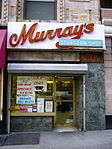The Greystone
1924 architectureManhattan building and structure stubs
The Greystone, also known as the Greystone Hotel is a fourteen-story building at 212-218 W. 91st Street on Manhattan's Upper West Side. Samuel and Henry A. Blumenthal bought the property from the Astor estate in 1922 with marketing beginning two years later. It was designed by the architectural firm of Schwartz & Gross.The building is currently in residential use and the former ballroom has since been a series of restaurants including Polistina's and Big Daddy's.Among its notable residents was Alberto Arroyo.
Excerpt from the Wikipedia article The Greystone (License: CC BY-SA 3.0, Authors).The Greystone
West 91st Street, New York Manhattan
Geographical coordinates (GPS) Address Nearby Places Show on map
Geographical coordinates (GPS)
| Latitude | Longitude |
|---|---|
| N 40.79125 ° | E -73.97375 ° |
Address
West 91st Street 212
10024 New York, Manhattan
New York, United States
Open on Google Maps







